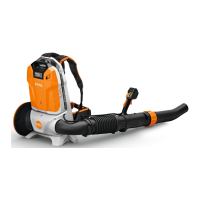0458-724-8601-A
6
English
5 IMPORTANT SAFETY INSTRUCTIONS
5.3 Operator
WARNING
■ Working with the blower can be strenuous. The operator
must be in good physical condition and mental health. To
reduce the risk of personal injury from fatigue and loss of
control:
– Check with your doctor before using the blower if
you have any health condition that may be
aggravated by strenuous work.
– Do not operate the blower while under the influence
of any substance (drug, alcohol or medication, etc.)
that might impair vision, balance, dexterity or
judgment.
– Be alert. Do not operate the blower when you are
tired. Take a break if you become tired.
– Do not permit minors to use the blower.
■ According to STIHL's current knowledge, the electric
motor of this blower should not interfere with a
pacemaker.
– However, persons with a pacemaker or other
implanted medical device should consult their
physician and device manufacturer before operating
this blower.
5.4 Personal Protective Equipment
WARNING
■ To reduce the risk of personal injury:
– Always wear proper clothing and protective apparel,
including proper eye protection.
■ Loss of control and severe injuries may result if hair,
clothing or apparel are drawn into the air intake or
otherwise become entangled in the components of the
blower. To reduce the risk of severe personal injury:
– Wear a long-sleeve shirt or jacket.
■ To reduce the risk of eye injury:
■ Prolonged exposure to power tool noise may result in
permanent hearing damage. To reduce the risk of hearing
damage:
■ Good footing is very important. To help maintain a secure
footing and reduce the risk of injury while working:
■ To help reduce the risk of personal injury caused by loss
of control during operation:
– Wear sturdy and snug-fitting clothing that
also allows complete freedom of
movement.
– Wear overalls or long pants made of
heavy material to help protect your legs.
Do not wear shorts.
– Avoid loose-fitting jackets, scarves,
neckties, flared or cuffed pants, jewelry
and any other apparel that could be
drawn into the air intake.
– Secure hair above shoulder level before
starting work.
– Always wear goggles or close-fitting
protective glasses with adequate side
protection that are impact-rated and
marked as complying with ANSI Z87 "+".
– Wear sound barriers (ear plugs or ear
muffs).
– Regular operators should have their
hearing checked periodically.
– Be particularly alert and cautious when
using hearing protection. Your ability to
hear shouts, alarms or other audible
warnings is restricted.
– Wear substantial footwear with non-slip
soles. Do not wear sandals, flip-flops,
open-toed or similar footwear.

